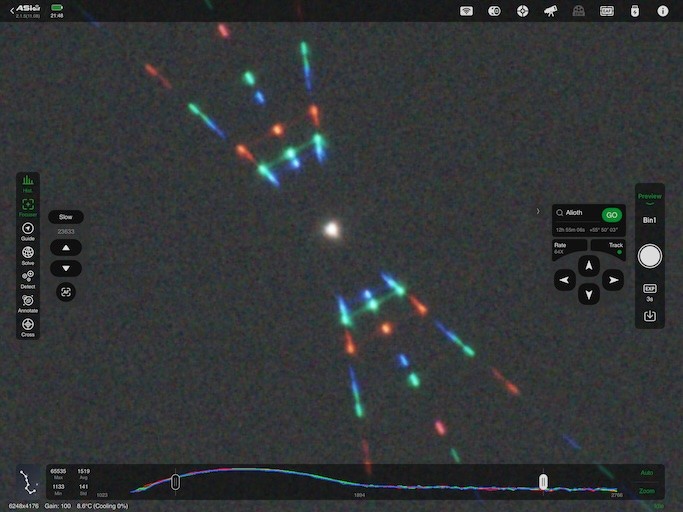retman you referenced a supplier of Bahtinov masks that you liked
Most (especially the cut out plexigalss ones from William Optics, and the 3D printed ones) are pure junk. They are so imprecise that either the diffraction spikes have dispersion, or the central star is a complete messy blob, making it hard to determine when the diffraction spikes actually passes through the central point.
I have been happy with the laser etched plexiglass and the ones that are created on negative films. This is what you get from one of them:

Notice the tightness of a central star.
Instead, the cheap junk produces diffraction that typically look like this (big fat bright blob where a small central star should be):
https://en.wikipedia.org/wiki/File:Bahtinov_mask_example.jpg
Since the lines are etched on plexiglass (or printed on negative film), there are no extra superfluous lines in the mask to act as mechanical support -- those (result of the Fourier Transform) produces confusing diffration patterns, instead of a small tight, central star, which makes it hard to find the correct focus.
The etched masks have very fine structure, so they generate a humongous sized diffraction pattern. If you have not seen one, you will be in for a culture shock. So, you can really see when the diffraction spikes pass through the central star.
Most of these masks are made to be mounted on 77mm or 82mm camera filter threads (I have a 82mm one mounted inside Thousand Oaks solar filter cell that I have cut the solar film away -- makes a nice fit to my FSQ-85). They also come in the 100mm x 100mm variety for 100mm filter holders. So, you need to do a little work to make them fit an astrograph instead of a camera lens.
There are quite a few purveyors of the 100mm x 100mm and 77mm/82mm etched plexiglass ones, and they appear to all come from the same OEM, or else they are shamelessly copied. Among these are ones from Kase, Lonely Speck, SkyLabs, K&F, Kenko, etc. Don't search for "Bahtinov" on Google, but "Focusing Mask."
A Hungarian company ("Focus On Stars," a one man company, I believe) makes a very unique Bahtinov mask that is "printed" onto photographic negatives (those who have been doing astrophotography from the Tri-X days will know what I mean) and the structures are even more precise and smaller than the etched glass ones. The photo negative is then sandwiched between two thin 100mm x 100mm plexiglas plates. The size and brightness of the diffraction pattern from them are nothing short of shocking.
One thing (and this really only apply to camera lenses, since most OTA are slower than f/4) that you will notice of a typical three-section Bahtinov mask is that at the corners of a full frame sensor with fast (f/2.8 or faster) lenses, instead of the typical 6 spikes, you will only see 4 or two of them, because the light ray bundle does not hit all three sections of the mask. Well, "Focus On Stars" has a solution for that too. Because he can print very small structures, he has a version of his mask (for fast lenses), he created instead of one mask, a NxN mosaic of smaller masks. So the ligh rays from all stars will pass through at least one of the smaller NxN masks. Now, these only work with very fast lenses and do not work on slower OTAs. I have both (fast and slow) versions of his masks, and can confirm that.
So, shop around. I am not a YouTube shill, and refuse to recommend any single manufacturer, so do your own homework. The etched plexiglass ones are pretty much equivalent (at least the 4 that I tried even looked the same). The one from Hungary is more unique, but you don't have to use his if you don't crave even larger and brighter spikes from the etched plexiglass ones, or if you don't need his fast lens version.
Now, all that being said. I have discovered why ASIAIR "autofocus" pretty much consistently fails for certain OTA. Knowing its shortfall allows me to now use the autofocus function very reliably, just absurdly slow. But that is a different subject, not what you asked. I will gladly address it if someone else is interested on how to make ASIAIR autofocus work properly. When I have patience that evening, or too lazy to go outdoors to mount masks, and if I am using ASIAIR, I simply use its autofocus feature now.
Chen